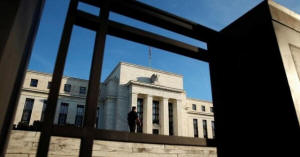|
Warmup begins for the
Great U.S. Rate Hike of 2016
 Send a link to a friend
Send a link to a friend
 [October 29, 2016]
By Ross Finley [October 29, 2016]
By Ross Finley
LONDON (Reuters) - Several of the world's
top central banks will meet in the coming week, but only one, the U.S.
Federal Reserve, is set to start a final countdown on the second most
anticipated event of the year after the Presidential Election.
Fed Chair Janet Yellen and the rest of the Fed's policy-setters appear
to have left themselves the December meeting to deliver a rate rise in
2016, with hardly anyone expecting a move only a week before the Nov. 8
election.
If the Fed does go ahead the following month, as most in financial
markets and analysts polled by Reuters now expect, it will have been a
full year since the last increase and three short of the number of moves
the Fed had anticipated back then.
Apart from a surprise outcome in an election where nearly every poll
puts Democratic Party candidate Hillary Clinton several percentage
points ahead of Republican Donald Trump, the conditions to justify a
long-awaited rate rise are lining up.
Growth bounced back to an annualized 2.9 percent in the third quarter,
at the high end of expectations, driven by inventory investment and a
rebound in exports.

Crucially, nascent signs of inflation pressure - the missing ingredient
up until now - are rattling sovereign bond markets around the globe,
suggesting that few people are clinging to hope that the Fed will delay
once more.
The Federal Open Market Committee, which already had three members
voting for a rate rise at the September meeting, is expected to make
clear in its statement that it has taken note of these improvements,
however subtly.
"With market expectations for a December hike running higher this year
compared with the same time last year, the Fed need not be as explicit
in its message of intent at this meeting compared with the October
statement in 2015 ahead of lift-off," economists at Morgan Stanley said.
"Nevertheless, we expect that a simple change in the statement will send
a clear message to markets that, barring any unforeseen hiccups, the Fed
is a go for a December hike."
Several important U.S. data releases should support that view in the
coming week, with manufacturing growth expected to hold up and
already-strong expansion in the much larger non-manufacturing industries
due to accelerate.
The October employment report at the end of the week is also forecast to
show solid if not spectacular hiring - normal this far into an economic
expansion - along with wage growth around 2.5 percent, above the rate of
inflation.
EXPECTED INFLATION TO TIE BANK OF ENGLAND'S HANDS
Across the Atlantic, the Bank of England's Monetary Policy Committee
will meet to consider a different kind of inflation challenge from a
very different angle.
[to top of second column] |

A police officer keeps watch in front of the U.S. Federal Reserve in
Washington October 12, 2016. REUTERS/Kevin Lamarque

The coming surge in imported inflation as a result of the pound's collapse since
Britons voted on June 23 to leave the European Union has considerably narrowed
the central bank's wiggle room for another rate cut below 0.25 percent.
BoE Governor Mark Carney said on Thursday the MPC can't ignore that "fairly
substantial" drop and there were limits to how willing the MPC would be to look
through an inflation overshoot, now expected to be well above the 2 percent
target.
"Of course, it is hard to say exactly how much of an overshoot the MPC will
tolerate, but the very fact that the Governor made this statement so soon before
the Inflation Report does suggest a wariness about the inflationary impact of
recent sterling declines," economists at Investec said.
"And, if the Governor has become skeptical about cutting Bank Rate in such
conditions, he will probably build a constituency in the MPC to vote down any
move to cut."
The majority of economists polled by Reuters have pushed a rate cut off the
table for this year, with some traders in financial markets already speculating
on the next move up. [BOE/INT]
The latest British manufacturing and services business surveys are due as well,
but they aren't likely to change a rate picture dominated by concerns about the
pound and what kind of replacement trade agreements Britain will set up - and
how soon.
The Bank of Japan is due to meet early in the week, but few expect it to make
any changes to policy after recently implementing an overhaul of its tools. More
easing is a way off, and is more likely to be a response to an external shock.
Governor Haruhiko Kuroda's tone of late suggests he has left behind his
aggressive stance of the recent past, which has done next to nothing to boost
inflation in Japan.

The Reserve Bank of Australia is also forecast to leave rates steady on Tuesday,
following cuts in May and August, according to a Reuters poll of 60 economists.
(Editing by Larry King)
[© 2016 Thomson Reuters. All rights
reserved.] Copyright 2016 Reuters. All rights reserved. This material may not be published,
broadcast, rewritten or redistributed. |